Learning Modalities Theory
Learning modalities theory is a framework that describes how different individuals prefer to learn and process information. There are various models of learning modalities, but one common framework categorizes them into four types: visual, auditory, kinesthetic, and reading/writing.
Visual learners prefer to use images, diagrams, charts, maps, and other visual aids to learn new information. They can easily recall what they see and have a good sense of spatial orientation. Visual learners may benefit from using color coding, highlighting, flashcards, and mind maps to organize and remember information.
Auditory learners prefer to use sound, music, speech, and other auditory stimuli to learn new information. They can easily recall what they hear and have a good sense of rhythm and tone. Auditory learners may benefit from using mnemonics, rhymes, songs, podcasts, and lectures to enhance their learning.
Kinesthetic Learners
Kinesthetic learners prefer to use movement, touch, and physical activity to learn new information. They can easily recall what they do and have a good sense of coordination and balance. Kinesthetic learners may benefit from using hands-on activities, experiments, simulations, games, and role-playing to engage their learning.
Reading/writing learners prefer to use text, books, notes, and other written materials to learn new information. They can easily recall what they read and write and have a good sense of grammar and vocabulary. Reading/writing learners may benefit from using outlines, summaries, lists, essays, and journals to reinforce their learning.
Learning modalities theory suggests that different learners have different strengths and weaknesses. They can improve their learning outcomes by matching their preferred modality with the appropriate instructional strategies. However, some researchers have challenged the validity and usefulness of learning modalities theory. Arguing that there is little evidence to support its claims and that it may lead to oversimplification and stereotyping of learners. They suggest that learners should use a variety of modalities and strategies to optimize their learning, depending on the content, context, and goals of their learning.
COVID-19 Pandemic Changes in the Educational Landscape
Learning modalities theory is not a new concept, but it has gained more attention and popularity in recent years due to the rapid changes in the educational landscape caused by the COVID-19 pandemic. The pandemic forced many educators and learners to transition from face-to-face to online or hybrid modes of teaching and learning. Which posed many challenges and opportunities for adapting to different learning modalities.
Some studies have explored the impacts of learning modality changes on students’ perception, comfort, self-efficacy, and performance in online learning environments. Using frameworks such as the Community of Inquiry (CoI) model. The CoI model proposes that online learning experiences are influenced by three interdependent elements: social presence, cognitive presence, and teaching presence. These elements can be used to measure and improve the quality and effectiveness of online learning modalities.
Summary
Learning modalities theory and its types are still evolving and developing. As new research and evidence emerge from the changing educational contexts and needs. Learning modalities theory can be a useful tool for understanding and enhancing one’s own learning preferences and processes. As well as for designing and delivering more inclusive and diverse learning experiences for others.
